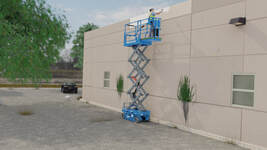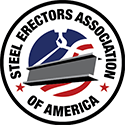 Mobile elevating work platforms (MEWPs) are indispensable tools when it comes to allowing workers to work safely at height. However, there are specific hazards associated with their operation that operators must be aware of. These hazards have been identified by the manufacturers, can be found in the operator's manual for each model, and are to be observed in conjunction with all other workplace safety rules and regulations. One of the hazards that operators must always be on the alert for is windy conditions. Per ANSI1, outdoor-rated MEWPs must be designed to be stable in winds up to 28 mph if all other factors are taken into consideration, which I will discuss further in a moment. Any wind above 28 mph will place the machine, and the occupants, in serious jeopardy. One unfortunate example of that is described on the OSHA Scissor Lift Fact Sheet 2: “Caution: Wind Can Make Extended Scissor Lifts Unstable. During the Fall 2010 college football season, a student who was also an employee of the University of Notre Dame was killed while filming the school’s football team practice from a scissor lift. Reportedly, the untrained worker raised the lift over 39 feet to film the practice. The wind gusts that day were more than 50 miles per hour. The high winds blew the lift over, killing the worker.” Please note that this example from the OSHA Scissor Lift Fact Sheet stresses that the individual was untrained. One comment that I often hear from untrained operators is, “I thought it would be safe or it wouldn’t let me go up.” The fact is that MEWPs are only machines, and even with all the safety devices that are designed into them, they are only truly safe in the hands of well trained, well supervised operators. Best Practices In the latest round of ANSI A92 design standards3, there are provisions for both outdoor rated and indoor-only rated machines. Indoor-only machines can only be used in areas that are not exposed to any wind whatsoever. This even includes warehouses or other structures with open bay doors. All MEWPs that were manufactured to the previous standards are unaffected by that change. However, it is important to note that some manufacturers released indoor-only machines before the standards changed, so it’s important to be aware of the limitations on the MEWP being used. Indoor-only MEWPs must be clearly marked to that effect in a durable manner in an easily visible place. Many new scissor lifts provide an option to switch between indoor and outdoor modes. Operators should never use a machine in indoor mode while working outside, or in areas where the air is moving (such as around large shop fans). When using outdoor-rated MEWPs, in outdoor mode, the best rule of thumb is if you are not comfortable with the situation, don’t go up. If you are elevated and wind speeds do exceed 28 mph, immediately lower the MEWP and do not continue to operate the machine. There are tools that can be used to estimate wind speed, such as the Beaufort Wind Chart4, and if you are unsure, small handheld wind meters (anemometers) are available online for less than $30. There are other factors concerning wind that need to be taken into consideration as well. The combined weight of the occupants, materials, tools, and any options or accessories must never exceed the rated platform capacity of the MEWP. Care must be taken when handling building materials, sheet materials, panels and other such materials that can act as sails. No modifications or additions to the MEWP that affect its wind loading — and consequently its stability — should be made without the manufacturer’s approval. Certain manufacturer-approved options and accessories, such as panel cradles and material holders (when installed) can impose a reduced maximum wind speed rating. The shielding and funneling effects of certain structures can cause high wind speeds and turbulence on days when the wind speed in open areas is low, so caution should always be taken when working between buildings, in alleyways or other confined spaces. Other potential sources of local high wind speed that must be taken into considered in relation to safety at worksites are at airports and along roadways. 1ANSI A92.20-2021.4.2.2.4.1.1 2 Working Safely with Scissor Lifts 3 ANSI A92.20-2021.6.4.7 4 Beaufort Wind Chart — Estimating Wind Speeds This Safety Flash was contributed by Scott Owyen, Genie Director of Training in cooperation with SEAA’s Safety Committee. It is designed to keep members informed about ongoing safety issues and to provide suggestions for reducing risk. Best practices are gathered from a variety of sources. They may be more or less stringent than individual corporate policies and are not intended to be an official recommendation from SEAA. Always get approval and direction from your company officers on any new practice or procedure as these best practices may not work for all situations. Everyone benefits when a worker avoids injury. Submit your ideas for Safety Flash to [email protected]. Comments are closed.
|


 RSS Feed
RSS Feed
